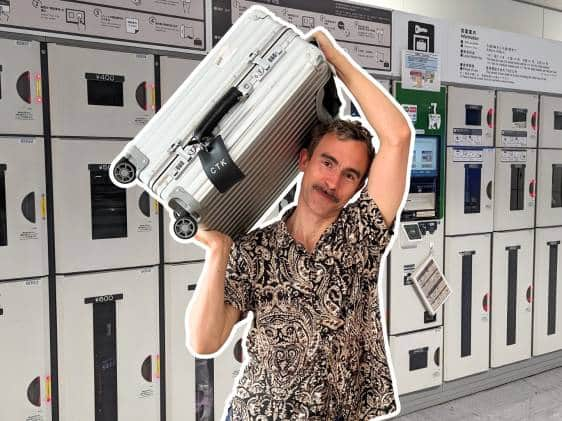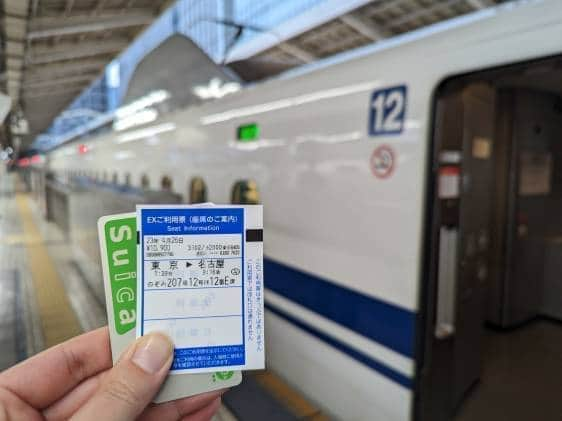Yokohama is Japan’s second-largest city and the perfect day trip from Tokyo. Take the chance to explore gardens, admire some art and fill up on Chinese food!

Although it might seem a little counter intuitive to plan day trips to a city 30 minutes from Tokyo, especially when places like Hakone and Kamakura are a stone’s throw away, Yokohama is worth it. A thriving port town since the end of Japan’s period of isolation in the mid-19th century, it is home to beautiful gardens, a bustling Chinatown, more ramen than you can shake a stick out and some stunning sunset views. The city is a mix of old and new, with contemporary art filling ex-brothels and neon-lit clocks illuminating red-brick warehouses. There is more than enough to fill a day in Yokohama, so our itinerary is just a suggestion: pick and choose to make your ideal day trip!
A morning stroll through Sankei-en Garden

Donated to the city of Yokohama by the Hara family in 1953, Sankei-en is a green escape from the city streets, with historical buildings, a traditional Japanese design and enough land to obscure to city from view. After extensive damage during WWII, the Hoshokai fund was created to fund the repairs, and the garden slowly returned to its former glory.
There are several tea houses to rest in and try the seasonal wagashi with matcha, as well as a stunning three-story pagoda and beautifully restored daimyo residence. In fact, the garden’s feel more like Kyoto than nearby Tokyo—especially since the pagoda once belonged to the ancient capital’s Tomyoji Temple. The gardens have become the new home to many traditional buildings from across Japan, with ten declared as Important Cultural properties and three as Tangible Cultural Properties. Spread over 175 thousand square meters, the garden is an unmissable spot in Yokohama, especially during plum and cherry blossom seasons as well as during autumn.
Admission: 500 yen
Hours: 9am – 5pm (Last entry 4:30pm) | Closed Dec 29th – 31st
Access: From Yokohama Station East Exit, catch bus number 8 or 148 and alight at Honmoku Sankeien-mae bus stop or Sankeien-iriguchi. This journey should take half an hour and will cost 220 yen each way.
Lunch in Chinatown

If you hop back on the number 8 bus from Sankei-en you can get off a few steps from the heart of Asia’s largest Chinatown. With between 3-4,000 residents, the town is a bustling hub of shops, restaurants and businesses as well as some stunning buildings and temples. Lunch is always the cheapo-trick to getting a great meal for a low price, so take advantage of the all-you-can-eat deals that start from around ¥1,500. That’s if you can avoid the temptation of the delicious steamed buns and other street food offered, with fried sesame balls, shouronbou (soup-filled dumplings), egg tarts and shumai (pork dumplings) all making a good case for a street lunch.
The shops have everything from bright souvenirs to hand-crafted items and are fun to look around even if your budget is non-existent. Be sure to visit the area’s two temples: Kanteibyo and Masobyo which are both elaborately decorated and beautifully lit at night.
Afternoon antics in the Cup Noodle Museum

A great rainy-day alternative to the gardens (or just a great addition to the day) the Cup Noodle Museum is no ordinary museum. With eye-wateringly bright displays tracing of the development of the once simple chicken ramen to today’s assortment of international flavors and creations, even the more traditional museum part is pretty fun. You can learn about the history of the much-loved (too-much-loved?) creator of instant ramen, Momofuku Ando through displays, inspirational quotes and a hallucinogenic film about his life and creation process.
That is all just jazzed-up museum stuff, I hear you cry. Fear not, I have only just begun. Step on through to the My Cup Noodle Factory where you can design your own noodle cups along with choosing what goes inside them, turning handles and heat sealing the saran wrap yourself! Still not enough for you? If you book ahead, you can make your own noodles from scratch in the cooking classes, leaving with your own fried and packaged noodles as well as an undeniably-fashionable bandanna.
Once you’ve sated your craft-appetite, you can move on to the real one and enjoy a variety of noodle-dishes from around the world at the Noodle Bazaar—an attractively decorated food hall with very cheapo-friendly dishes (just don’t try the ice cream). Kids can experience the noodle life for themselves at the indoor play area and you can round off your trip by admiring the marble noodle run before exiting through the gift shop.
Entry: 500 yen (plus 500 yen for the cooking class, 300 yen per meal and 300 yen for each cup noodle pot made)
Hours: 10am – 6pm (last entry 5pm) | Closed on Tuesdays and national holidays.
Access: The museum is an 8-minute walk from Minatomirai Station (which is a three-minute train ride from Yokohama), or a 28-minute walk from Yokohama Station.
Explore the arts and architecture

With a checkered history and plenty of secrets, Yokohama has been reviving forgotten areas and creating artistic havens and galleries for a new generation. The locations are scattered across the city and include red-light districts, warehouses and piers stretching out into the sea—but it’s easy to incorporate them for an alternative view of the city. Having been badly combed in the war, the Koganecho area soon became a den of drugs and prostitution, and although the former was cleared out in the 60s, the latter was left to prosper until 2005 (priorities). This left a series of narrow properties and dodgy alleyways—art was the answer. The Koganecho Area Management Center has created artists residences in ex-brothels, exhibition spaces in train tunnels and community in a once-doomed area. The area is great for a stroll with small galleries and shops as well as river-side cafes.
Closer to Chinatown, you’ll find BankART 1929—a dock-side hub of arts and culture with spacious galleries favoring impressive art installations as well as live studios, lectures and performance area. They house eight artists on three-month residencies ensuring a fresh rotation of art as well as having a cafe that later becomes a bar complete with abandoned bus and dock views.
Oosanbashi Pier is the perfect place to admire the architecture of the city in a single sweeping glance, encompassing new and old while standing on one of the most influential pieces. Inspired by natural shapes, the pier features no stairs, posts or beams and light flows naturally with grass-covered top and a definite popularity as a romantic spot.
For more information on the best spots have a read of our article on the thriving art scene in Yokohama.
Settle in for a Minato Mirai sunset

Nabbing one of the slightly uncomfortable benches on top of the pier, you can watch as the sun sets behind the carefully designed skyline of MinatoMirai (and might just see Fuji in the distance too). From the aforementioned Osanbashi Pier, the view is pretty spectacular, and if you plan ahead and bring a chu-hai, there isn’t a better way to end the day. The city has undergone quite a transformation, and you can see the famous Red Brick Warehouse alongside the world’s largest clock, backed by the ever-lit business towers of the city.
Eat and be merry in the bars and izakaya of Noge

Close to the revitalized area of Sakuragicho, Noge was left behind when the renovation of Yokohama began, and remains a densely packed, slightly sketchy area (by Japan’s standards at least). This makes it one of the best spots to visit, as you can experience Japan as close to its Showa past as possible.
With dusty bars, grubby neon-lights ad plenty of music, the area has a charm to it, as well as plenty of happy customers, with locals and Tokyoites making the trip down for jazz and drinks hard to find elsewhere. In October, Noge is host to the Yokohama Jazz Festival, but there are small gigs throughout the year, with each bar hosting international and local performers.
Wander the streets and duck into any spot that takes your fancy, be it a yakitori joint with plenty of beer or a smokey jazz club with wine and cigars … just don’t forget to catch your last train back to Tokyo!
Bonus ideas for a Yokohama day trip:
Hikawa Maru Floating Museum
The Hikawa Maru once sailed the seas as an ocean liner, carrying passengers including Charlie Chaplin as well as hundreds of Jewish refugees fleeing Nazi persecution before becoming a hospital ship in WWII. Now docked permanently in Yokohama’s Yamashita Park, she is a museum, painstakingly maintained with art deco lounges, luxurious cabins and classic design. Now a cultural asset of the city, the ship is well worth a visit for a glance into the past of a flourishing port town.
Admission: 300 yen (250 yen if you use this voucher)
Hours: 10am – 5pm (last entry 4:30pm) | Closed Mondays, unless it is a national holiday.
Access: The boat is a 3-minute walk from Exit 4 of Motomachi-chukagai Station
Getting to Yokohama from central Tokyo
Yokohama is a short train journey from Tokyo’s major stations and is very simple to get to!
- From Shinjuku take the Shonan-Shinjuku line for just over half an hour at a cost of 540 yen.
- From Shibuya, it’s a 25-to-30-minute journey on the Shonan-Shinjuku line or the Tokyou Toyoko/Minatomirai lines respectively, although the second option is around 120 yen cheaper at 270 yen.
- From Tokyo Station you can hop on the Yokosuka or Tokaido lines—both are JR, cost 470 yen and take about 30 minutes to get you to Yokohama.
- From Shinagawa it’s a simple 20-minute jaunt on JR Tokaido line or the Keikyu Main line, costing 290 yen or 300 yen respectively.































